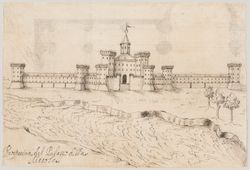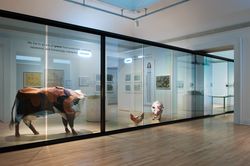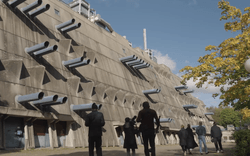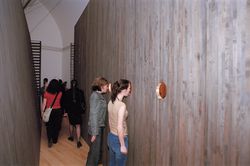Projet
AP180.S1.1964.PR01
Description:
This project series documents Umberto Riva's realized redesign for the interior spaces of the Casa della cultura. Riva worked on this project in 1964. The Casa della cultura is a cultural centre that offers courses and seminars, as well as holds debates on cultural and political topics. The centre is located on via Borgogna in Milan, Italy. The project series contains floor plans, interior sections, and details, including furnishing details and details for signage letters.
1964
Casa della cultura [Cultural centre], Milan, Italy (1964)
Actions:
AP180.S1.1964.PR01
Description:
This project series documents Umberto Riva's realized redesign for the interior spaces of the Casa della cultura. Riva worked on this project in 1964. The Casa della cultura is a cultural centre that offers courses and seminars, as well as holds debates on cultural and political topics. The centre is located on via Borgogna in Milan, Italy. The project series contains floor plans, interior sections, and details, including furnishing details and details for signage letters.
Project
1964
archives
Niveau de description archivistique:
Fonds
Fonds Peter Eisenman
AP143
Résumé:
The Peter Eisenman fonds documents Eisenman's professional activities as an architect, teacher, and author from the 1950s to 2008. More than 200 projects are represented through conceptual and design development drawings, models, photographs, textual records, and computer-aided drawings. Also well represented in the fonds are materials related to Eisenman's exhibitions, publications, and writings.
1925-2008, predominant 1951-2008
Fonds Peter Eisenman
Actions:
AP143
Résumé:
The Peter Eisenman fonds documents Eisenman's professional activities as an architect, teacher, and author from the 1950s to 2008. More than 200 projects are represented through conceptual and design development drawings, models, photographs, textual records, and computer-aided drawings. Also well represented in the fonds are materials related to Eisenman's exhibitions, publications, and writings.
archives
Niveau de description archivistique:
Fonds
1925-2008, predominant 1951-2008
Architecte et ingénieur en hydraulique, Luca Danese est actif dans le nord-est de l’Italie durant la première moitié du XVIIe siècle. Sa carrière, bien qu’ancrée dans la géographie particulière du delta du Pô, sera influencée et façonnée par l’hydropolitique plus large du gouvernement papal, occupé à transformer l’infrastructure hydraulique de Rome. C’est aussi l’époque(...)
Salle d'étude Mot(s)-clé(s):
chercheur en résidence 2023, séminaire, recherche, Andrea Bagnato, Luca Danese, Italie, XVIIe siècle, hydropolitique, eau
6 juillet, 18 h
Séminaire de chercheur en résidence : Andrea Bagnato
Actions:
Description:
Architecte et ingénieur en hydraulique, Luca Danese est actif dans le nord-est de l’Italie durant la première moitié du XVIIe siècle. Sa carrière, bien qu’ancrée dans la géographie particulière du delta du Pô, sera influencée et façonnée par l’hydropolitique plus large du gouvernement papal, occupé à transformer l’infrastructure hydraulique de Rome. C’est aussi l’époque(...)
Salle d'étude Mot(s)-clé(s):
chercheur en résidence 2023, séminaire, recherche, Andrea Bagnato, Luca Danese, Italie, XVIIe siècle, hydropolitique, eau
recherche
Thème : Le phénomène de changements de paradigmes en architecture depuis l’Antiquité : Brigitte Desrochers, Musée des Beaux-Arts du Canada, Ottawa, Canada Sujet : Au-delà du style. Naissance du classicisme structurel dans les ruines de Pompei Joseph Disponzio, Graduate School of Design, Harvard University, Cambridge, États-Unis Sujet : Jean-Marie Morel and the Invention(...)
septembre 2001 au août 2002
Chercheurs en résidence 2001-2002
Actions:
Description:
Thème : Le phénomène de changements de paradigmes en architecture depuis l’Antiquité : Brigitte Desrochers, Musée des Beaux-Arts du Canada, Ottawa, Canada Sujet : Au-delà du style. Naissance du classicisme structurel dans les ruines de Pompei Joseph Disponzio, Graduate School of Design, Harvard University, Cambridge, États-Unis Sujet : Jean-Marie Morel and the Invention(...)
recherche
septembre 2001 au
août 2002
Projet
AP018.S1.1978.PR05
Description:
This project series documents the Ontario Congress and Trade Centre in Toronto from 1978-1980. The office identified the project number as 7807. This project consisted of the investigation of building a congress and trade centre on Front Street West. The project proposed a 519,500 square foot building with a 200,000 square foot exhibition hall that could be divided for smaller events. The building would also contain a multiuse hall, theatres, meeting rooms, offices, food and beverage facilities, and a 1300 car parking area. The project was proposed to cost around $73 million. The project is also referred to as the Toronto Convention Centre or Ontario Convention Centre. The majority of the textual documentation shows the controversial debate over whether the centre should be built, including numerous press clippings that highlight the issue. It should be noted that Congress Centre and Convention Centre are used interchangeably in the materials. Eventually, this project contract was given to another architectural firm and today is known as the Metropolitan Toronto Convention Centre. The project is recorded through drawings and textual records dating from 1976-1981. The drawings largely show designs for the proposed building and site plans. The textual records include correspondence, meeting minutes, interoffice memos, project proposals, feasibility reports, press clippings on the project and on other convention centres, research documentation on other convention centres, documentation on a proposed hotel to be built on the centre and promotional materials.
1976-1981
Ontario Congress and Trade Centre, Toronto (1978-1981)
Actions:
AP018.S1.1978.PR05
Description:
This project series documents the Ontario Congress and Trade Centre in Toronto from 1978-1980. The office identified the project number as 7807. This project consisted of the investigation of building a congress and trade centre on Front Street West. The project proposed a 519,500 square foot building with a 200,000 square foot exhibition hall that could be divided for smaller events. The building would also contain a multiuse hall, theatres, meeting rooms, offices, food and beverage facilities, and a 1300 car parking area. The project was proposed to cost around $73 million. The project is also referred to as the Toronto Convention Centre or Ontario Convention Centre. The majority of the textual documentation shows the controversial debate over whether the centre should be built, including numerous press clippings that highlight the issue. It should be noted that Congress Centre and Convention Centre are used interchangeably in the materials. Eventually, this project contract was given to another architectural firm and today is known as the Metropolitan Toronto Convention Centre. The project is recorded through drawings and textual records dating from 1976-1981. The drawings largely show designs for the proposed building and site plans. The textual records include correspondence, meeting minutes, interoffice memos, project proposals, feasibility reports, press clippings on the project and on other convention centres, research documentation on other convention centres, documentation on a proposed hotel to be built on the centre and promotional materials.
Project
1976-1981
Projet
AP018.S1.1972.PR02
Description:
This project series documents a feasibility study for a convention centre in Toronto from 1972-1973. The office identified the project number as 7228. This project consisted of a study to evaluate the feasibility of various downtown sites to build a convention centre, particularly sites close to the CN Tower and Union Station. The project also included the design of the convention centre, establishing realistic project costs and testing the building criteria with governments and committees. The debate on whether the convention centre should be constructed lasted throughout the 1970s and into the 1980s. Parkin Architects Planners also investigated specific sites and refined the design in the late 1970s, under a different project number (see project series AP018.S1.1978.PR05 described in this fonds), and the project was later referred to as the Ontario Congress and Trade Centre. It should be noted that Congress Centre and Convention Centre are used interchangeably in the materials. Eventually, the building contract was given to another architectural firm and today is known as the Metropolitan Toronto Convention Centre. The project is recorded through drawings, presentation boards and textual records dating from around 1972-1977. The drawings consist of plans, elevations, sections, diagrams and sketches, while the textual records include press clippings, project notes, correspondence, the feasibility report, conference reports, and the project proposal. The presentation boards consist of photographs of the project model, site investigation plans, and a painting of the project by Dawson.
circa 1972-1977
Convention Centre for Metropolitan Toronto, Feasibility Study, Toronto (1972)
Actions:
AP018.S1.1972.PR02
Description:
This project series documents a feasibility study for a convention centre in Toronto from 1972-1973. The office identified the project number as 7228. This project consisted of a study to evaluate the feasibility of various downtown sites to build a convention centre, particularly sites close to the CN Tower and Union Station. The project also included the design of the convention centre, establishing realistic project costs and testing the building criteria with governments and committees. The debate on whether the convention centre should be constructed lasted throughout the 1970s and into the 1980s. Parkin Architects Planners also investigated specific sites and refined the design in the late 1970s, under a different project number (see project series AP018.S1.1978.PR05 described in this fonds), and the project was later referred to as the Ontario Congress and Trade Centre. It should be noted that Congress Centre and Convention Centre are used interchangeably in the materials. Eventually, the building contract was given to another architectural firm and today is known as the Metropolitan Toronto Convention Centre. The project is recorded through drawings, presentation boards and textual records dating from around 1972-1977. The drawings consist of plans, elevations, sections, diagrams and sketches, while the textual records include press clippings, project notes, correspondence, the feasibility report, conference reports, and the project proposal. The presentation boards consist of photographs of the project model, site investigation plans, and a painting of the project by Dawson.
Project
circa 1972-1977
pages web
Le programme de résidence pour commissaires émergents offre la possibilité de présenter et de réaliser un projet en lien avec les débats contemporains sur l’architecture, l’urbanisme, l’architecture du paysage, et les dynamiques sociales et culturelles au cours d’une résidence au CCA.
Programme de résidence pour commissaires émergents
Actions:
Résumé:
Le programme de résidence pour commissaires émergents offre la possibilité de présenter et de réaliser un projet en lien avec les débats contemporains sur l’architecture, l’urbanisme, l’architecture du paysage, et les dynamiques sociales et culturelles au cours d’une résidence au CCA.
pages web
Alors que le débat politique contemporain se préoccupe particulièrement de notre santé, les architectes, urbanistes et architectes du paysage développent-ils un nouveau programme politique et moral pour répondre à ces préoccupations sociétales? En imparfaite santé étudie la complexité, la corrélation et l’émergence de ces problèmes sanitaires contemporains au travers des(...)
Salles principales Mot(s)-clé(s):
en imparfaite santé, giovanna borasi, mirko zardini, kersten geers, david van severen, office, kgdvs
25 octobre 2011 au 15 avril 2012
En imparfaite santé : La médicalisation de l’architecture
Actions:
Description:
Alors que le débat politique contemporain se préoccupe particulièrement de notre santé, les architectes, urbanistes et architectes du paysage développent-ils un nouveau programme politique et moral pour répondre à ces préoccupations sociétales? En imparfaite santé étudie la complexité, la corrélation et l’émergence de ces problèmes sanitaires contemporains au travers des(...)
Salles principales Mot(s)-clé(s):
en imparfaite santé, giovanna borasi, mirko zardini, kersten geers, david van severen, office, kgdvs
articles
Architecturer un changement
Forces de friction
9 décembre 2024
Architecturer un changement
Federica Zambeletti en conversation avec Arno Brandlhuber et Olaf Grawert
Actions:
Forces de friction
L’exposition Laboratoires explore comment l’architecture peut réagir au monde incertain de l’après 11 septembre et construire un nouveau cadre de réflexion. Six jeunes agences présentent des environnements ou des installations qui examinent le langage fondamental de la pensée architecturale et réaffirment les pouvoirs civilisateurs de l’imagination. Ont participé à cette(...)
Salles principales
18 avril 2002 au 15 septembre 2002
Laboratoires : Six agences de jeunes architectes dans les salles du CCA
Actions:
Description:
L’exposition Laboratoires explore comment l’architecture peut réagir au monde incertain de l’après 11 septembre et construire un nouveau cadre de réflexion. Six jeunes agences présentent des environnements ou des installations qui examinent le langage fondamental de la pensée architecturale et réaffirment les pouvoirs civilisateurs de l’imagination. Ont participé à cette(...)
Salles principales



